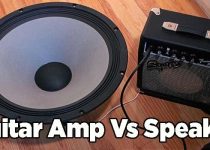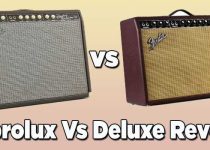5 Best Amps for Classical Guitar 2025: Top Picks for Perfect Tone
Finding the right amp is a challenge. Classical guitars require a very special amp. Nylon guitars have a very delicate tone. You must preserve that natural sound quality. The wrong amp easily distorts the sound. It can make your beautiful tone harsh. An amp should reproduce natural acoustic beauty. Your goal is transparent sound reinforcement. You want your sound to be louder. Your guitar’s true character must remain.
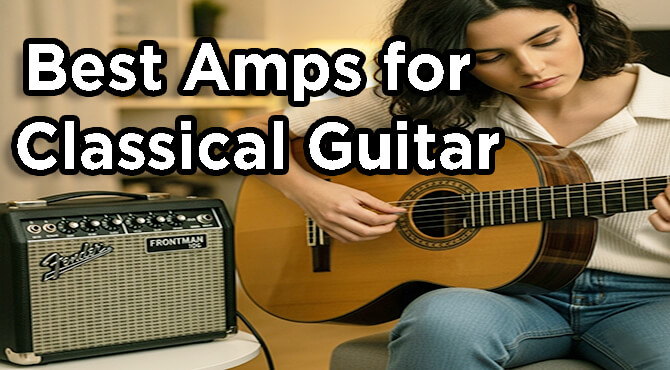
This guide helps you find the right amp. We make the difficult decision much easier. I present five of the best amps today. These amps are perfect for classical guitar. They also work well for flamenco styles. We find out why each amp is popular. I also share a helpful buying guide. It has many useful setup and sound tips. Let’s find the amp for your guitar.
# Table of Contents =>
- 1 5 Best Amps for Classical Guitar – 2025 Reviews:
- 1.1 1. Fender Frontman 10G – The Budget Practice Champion:
- 1.2 2. Fender Acoustasonic 40Watts – The Natural Performer
- 1.3 3. Positive Grid Spark 50W – Practice Amp
- 1.4 4. Fishman Loudbox Mini BT 60Watt – The Gigging Standard
- 1.5 5. Coolmusic BP40D (Portable Bluetooth Speaker 80W) –
- 1.6 How to Select A Classical Guitar Amplifier [Buying Guide]
- 1.6.1 1) Focus on Tonal Authenticity –
- 1.6.2 2) Choose the Right Power Level –
- 1.6.3 3) Speaker Size and Tone –
- 1.6.4 4) Count the Channels and Inputs –
- 1.6.5 5) Consider Portability and Battery Power –
- 1.6.6 6) Use Effects Tastefully, Especially Reverb –
- 1.6.7 7) Shape Your Sound with EQ Controls –
- 1.6.8 8) Connect to a PA with a DI Output –
- 1.7 Features Comparison Table –
- 1.8 Amplification Setup and Sound Tips –
- 1.9 Final Thoughts –
- 1.10 FAQs –
Top 5 Classical Guitar Amplifiers:
Amp Name => | Amp Image => | Features => | Check on Amazon => |
#1. Fender Frontman 10G Guitar Amp - (Budget Practice Amp) |
| ||
#2. Fender Acoustasonic 40Watts (The Natural Performer) |
| ||
#3. Positive Grid Spark 50W - (Best Practice Amp) |
| ||
#4. Fishman Loudbox Mini BT 60 Watt - (The Gigging Standard) |
| ||
#5. Coolmusic BP40D (Portable Bluetooth Speaker 80W) |
|
5 Best Amps for Classical Guitar – 2025 Reviews:
1. Fender Frontman 10G – The Budget Practice Champion:
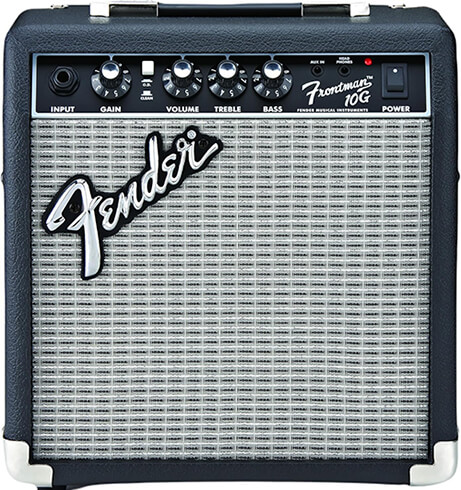
Overview:
The Fender Frontman 10G is a practice amp. It is a very recognizable practice amplifier. It’s a clean channel that works well for classical guitar. It is a very affordable practice option. This simple amp is a plug-and-play solution. It helps you to hone your technique.
Features:
- It delivers 10 watts of audio power.
- It has a six-inch Fender design speaker.
- Controls include volume, treble, and also bass.
- It has an overdrive switch for electrics.
- A headphone output allows for silent practice.
- An aux input lets you play along.
Pros & Cons –
Pros:
- This amplifier is extremely budget-friendly now.
- The simple controls are very easy to use.
- It is very compact and easy to carry.
- The headphone jack allows for silent practice.
Cons:
- Its bass response is a little too heavy.
- The tone is not ideal for acoustics.
- It does not have any built-in reverb.
- It lacks power for live performance venues.
Why You Would Use It –
Its popularity comes from affordability and reliability. Many beginners praise its simple, working design. It has been a top choice for decades. It delivers Fender tone in a small box.
You use this amp for quiet home practice. The headphone jack is great for nighttime. Its clean sound supports your nylon strings. It is very portable for music lessons.
2. Fender Acoustasonic 40Watts – The Natural Performer
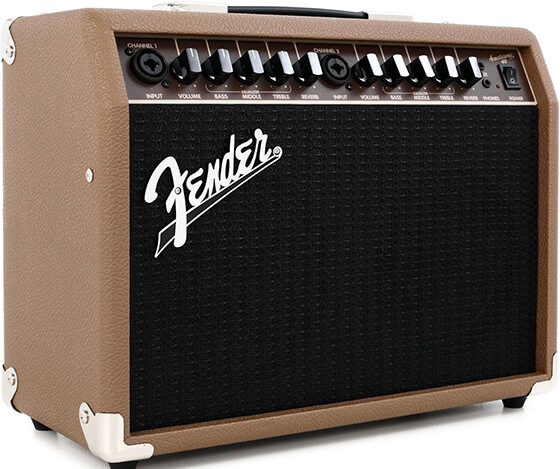
Overview:
The Fender Acoustasonic 40 is a great amp. It makes acoustic instruments sound their best. It enhances the guitar’s natural resonance beautifully. This amp is for small gigs or recitals. It gives a clean and authentic sound. It represents your guitar’s unplugged tone well.
Features:
- It has 40 watts of stereo power.
- Two speakers have special “whizzer” cone designs.
- It features two independent input channels.
- You can plug in a guitar and microphone.
- Each channel has its own 3-band EQ.
- It also has a digital hall reverb.
Pros & Cons –
Pros:
- The tonal clarity is absolutely excellent.
- Dual inputs are incredibly versatile for performers.
- The built-in reverb adds beautiful ambiance.
- The Fender build quality is very robust.
Cons:
- A headphone jack is surprisingly not included.
- It is slightly bulky for a practice amp.
- It does not have a battery power option.
- You need a wall outlet to use it.
Why You Would Use It –
This amp balances performance, price, and portability. It is a workhorse amp for many musicians and manages a guitar and mic perfectly. That is a very practical choice for artists.
You use this amp for live performances. It fills a room with natural sound. You rely on its lush reverb often. Dual inputs are great for collaborations.
3. Positive Grid Spark 50W – Practice Amp
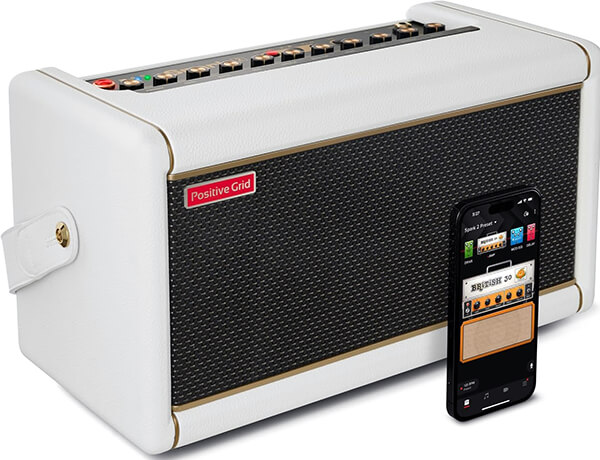
Overview:
Positive Grid Spark 50W is a smart amp. One of the Best Amps for Classical Guitar. It is a complete practice and recording tool. Normally uses advanced modeling technology with an app. That offers a universe of different tones. Its acoustic models work for classical guitar. The speakers give a full-range response.
Features:
- It has 50 watts of stereo power.
- It has two custom-designed four-inch speakers.
- The Spark App controls amps and effects.
- The app can create a backing track.
- It can also show you chords to songs.
- USB output allows for direct computer recording.
Pros & Cons –
Pros:
- Its versatility is truly unmatched by others.
- The practice tools make learning very fun.
- It functions as a quality USB interface.
- It can also be a Bluetooth speaker.
Cons:
- The best features require the smartphone app.
- Many options can be a distraction.
- The modeled sounds can feel less organic.
- Purists might prefer an analog signal.
Why You Would Use It –
The Spark 50W redefines practice amplifiers now. It is great for learning and composing. You use this amp to explore creativity. It is your partner for musical composition. You can learn difficult pieces with it. The USB output records your ideas easily.
4. Fishman Loudbox Mini BT 60Watt – The Gigging Standard

Overview:
The Fishman Loudbox Mini is an icon. It is one of the best acoustic amps. It delivers a warm and transparent tone. This sound is ideal for classical guitar. Bluetooth makes it even more versatile. It is the industry standard for performers.
Features:
- Offers 60 watts of clean power.
- It has a woofer and a tweeter.
- It features a dedicated instrument channel.
- It also has a separate microphone channel.
- A phase switch helps to stop feedback.
- Bluetooth allows for wireless backing tracks.
Pros & Cons –
Pros:
- It is known for legendary Fishman tone.
- Pro features make it ready for gigs.
- It is both powerful and very portable.
- Bluetooth adds a lot of convenience.
Cons:
- The plastic build feels less premium.
- It does not have a battery power option.
- The included effects are quite simple.
- You will need external pedals for more.
Why You Would Use It –
This amp has a reputation for reliability. Performers trust it for professional concert tone. It gives gigging guitarists everything they need. It is easy to transport and set up.
This is your main performance amplifier. You use it for solo recitals often. Its transparent tone projects your instrument. The DI output connects to a PA system.
5. Coolmusic BP40D (Portable Bluetooth Speaker 80W) –
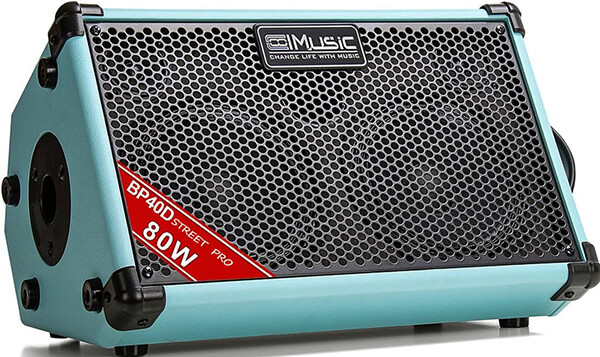
Overview:
The Coolmusic BP40D is a versatile amp. It is a battery-powered amp for performing. That works as a small personal PA system. This is great for small classical groups. It suits outdoor weddings or busking well. It is another Best Amps for Classical Guitar that provides high-quality sound on the go.
Features:
- It delivers 80 watts of peak power.
- A rechargeable battery lasts up to eight hours.
- It has six different inputs for gear.
- Two channels have phantom power for mics.
- It includes Bluetooth for wireless audio streaming.
- It has built-in effects like reverb.
Pros & Cons –
Pros:
- The battery lets you perform anywhere.
- Its massive connectivity is a huge plus.
- High power is great for outdoor use.
- Phantom power is a professional feature.
Cons:
- It is heavier than other options here.
- The controls may seem complex at first.
- Digital EQs can sound less organic.
- Some purists may dislike the sound.
It’s Popularity and Why You Would Use It –
It is popular with gigging musicians. They need flexibility away from an outlet. It functions as a self-contained PA system. It is a cost-effective choice for groups.
You use this amp for outdoor performances. It is perfect for a park or wedding. You rely on its long battery life. Multiple inputs amplify your entire ensemble.
How to Select A Classical Guitar Amplifier [Buying Guide]
Ready to choose the right amp? Here’s what to look for:
1) Focus on Tonal Authenticity –
Tonal authenticity is your highest priority. Your amplifier should sound like your guitar. It should not add any unwanted color. The amp must reproduce your natural sound. Look for amps called “transparent” or “acoustic.” These amps respect your instrument’s natural voice. They just make your beautiful guitar louder.
2) Choose the Right Power Level –
Consider how much power you really need. The right power level is very important. Ten watts is fine for home practice. It is not loud enough for stages. Thirty to sixty watts is for gigs. This power works for small coffee shops. Sixty watts fills a medium-sized concert venue. More power helps you play with bands.
3) Speaker Size and Tone –
The speaker size affects your overall tone. Acoustic amps often use eight-inch speakers. These speakers reproduce high frequencies very well. Some amplifiers also have a small tweeter. A tweeter adds much more clarity and sparkle. It helps articulate your nylon string sound. This gives your playing more subtle detail.
4) Count the Channels and Inputs –
Think about how many inputs you need. A solo player needs just one channel. Multiple channels are for voice and guitar. Singer-songwriters need two separate input channels. One channel is for your classical guitar. The other channel is for your microphone. You should look for an XLR input.
5) Consider Portability and Battery Power –
Portability is important for gigging musicians. A lightweight amp is much easier to carry. A battery helps you to play outside. A battery-powered amp works absolutely anywhere. You can perform your music in the park. It is perfect for busking or weddings. You are not tied to a wall outlet.
6) Use Effects Tastefully, Especially Reverb –
Reverb is the most important effect. It adds a beautiful sense of space. It makes your guitar sound more professional. The effect emulates a nice concert hall. You should use reverb very tastefully now. Too much reverb can muddy your sound. Other effects are not as important.
7) Shape Your Sound with EQ Controls –
EQ controls help shape your sound. They give you tonal shaping power. Look for bass, mid, and treble knobs. These knobs help you adjust for rooms. You can cut frequencies that cause feedback. Always start with the EQ knobs flat. Then make small adjustments for the space.
8) Connect to a PA with a DI Output –
A DI output is a professional feature. It connects to PA systems for shows. A DI output sends a clean signal. This is for playing in larger venues. The sound engineer gets a perfect signal. You sound great through the big speakers.
Features Comparison Table –
| Amp Model – | Best For – | Key – |
| Fender Frontman 10G | Budget Home Practice | Simplicity, Portability, Headphone Output |
| Fender Acoustasonic 40 | Small Gigs & Recitals | Natural Tone, Dual Inputs, Lush Reverb |
| Positive Grid Spark 50 | Creative Practice & Recording | AI Features, Looper, USB Interface |
| Fishman Loudbox Mini BT | Professional Solo Performance | Legendary Tone, Bluetooth, Pro Features (DI) |
| Coolmusic BP40D | Outdoor Gigs & Ensembles | High Power, Battery, Multiple Inputs, Phantom Power |
Amplification Setup and Sound Tips –
Always start with a flat EQ setting. This gives you a neutral starting point. Set all EQ knobs to twelve o’clock. This position is called the “flat” position. Play your guitar and listen very carefully. Adjust the sound slightly for the room. Each room has its own unique acoustics.
Use your reverb effect very tastefully. A little bit of reverb goes far. The goal is to emulate room ambiance. You want to sound like a concert hall. You do not want to sound too distant. Too much reverb will muddy your tone.
Your guitar’s pickup system is important. A great pickup provides a clean signal. The amp can only amplify its source. A quality pickup helps your amp shine.
Proper amp placement is a crucial skill. Never stand directly in front of your amp. Your guitar’s sound hole causes the feedback. Place the amp slightly behind you now. Or you can place it to the side. Point the amp toward your listening audience. This will help you to avoid feedback.
Final Thoughts –
Your classical guitar deserves a great amp. So, easy to choose the Best Amps for Classical Guitar from the above list. It is a subtle and graceful instrument. Your amplifier should honor its unique voice. These five amps are all excellent options. Each one serves a very different purpose. One is for quiet practice at home. Another is perfect for live stage performances. Another amp is for outdoor busking gigs.
This buying guide helps you choose well. You consider your own personal needs now. Think about your specific playing situation. Are you a student or a performer? Do you need a simple or complex amp? The perfect amp is waiting for you. Trust your own ears during the process. Choose wisely to elevate your unique sound.
FAQs –
Q1. Can I use an electric guitar amp for my classical guitar?
You can use an electric amp for your practice. It’s clean channel can work well in a pinch. However, the sound does not feel very natural. An acoustic amp better reproduces your guitar’s true tone. It is designed for authentic acoustic sound reproduction.
Q2. What is the most important feature for a classical guitar amp?
The most important feature is your tonal transparency. Your amp should preserve your guitar’s natural, warm voice. A high-quality reverb effect is also very essential. It adds a beautiful and subtle room ambiance. This makes your playing sound much more professional.
Q3. How many watts do I need for my classical guitar amp?
Your wattage needs depend on the performance venue. Ten to twenty watts is perfectly fine for practice. 40 to 60 watts works for all small gigs. You will need more power for playing with bands. Consider where you plan to play your music.
Q4. Do I need an amp with a microphone (XLR) input?
A microphone input is useful for many performers. It allows you to sing and play guitar together. You can also amplify another acoustic-type instrument. It is not necessary for your solo instrumental practice. This feature adds great performance flexibility for you.
Q5. How do I prevent feedback when amplifying my classical guitar?
Feedback is a loud, howling sound from the amp. Your guitar’s body resonates with the speaker’s own sound. Do not stand directly in front of your amp. You should place the amp behind you or side. Some amps have a phase switch to reduce feedback.
Last Updated on October 15, 2025 by Perry Garner

